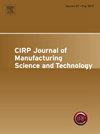Electrochemical milling–grinding of high volume fraction SiCp/Al composites with high surface quality via trajectory and process optimization
IF 5.4
2区 工程技术
Q2 ENGINEERING, MANUFACTURING
CIRP Journal of Manufacturing Science and Technology
Pub Date : 2025-04-28
DOI:10.1016/j.cirpj.2025.04.010
引用次数: 0
Abstract
Silicon carbide particle-reinforced aluminum matrix (SiCp/Al) is a composite material that is difficult to machine, particularly at high volume fractions. This study investigated the feasibility and stability of machining high volume fraction SiCp/Al using electrochemical milling–grinding (ECMG). Unstable electrochemical discharge machining (ECDM) can easily occur during traditional vertical plunge ECMG. Burn marks were observed on the machined surface, and energy-dispersive X-ray spectroscopy detected the presence of tool electroplating materials such as Ni and Cu on the workpiece, implying tool material adhesion. Modeling and simulations of the electrolyte flow field during the ECMG process demonstrated the critical role of electrolyte convection in material removal. A slow electrolyte flow velocity allowed machining debris and heat to build up in the machining gap, creating favorable conditions for abnormal discharge and material removal via ECDM. Therefore, the tool trajectory was modified from the original vertical plunge cut followed by horizontal cutting to an angled cut followed by reversed horizontal cutting. Simulation results indicated that the modified tool trajectory improved electrolyte flow field uniformity and velocity in the machining gap. Consequently, the electrolyte in the machining gap was continuously refreshed, leading to a stable ECMG process that was confirmed by the electrical signals collected from the power supply during machining. Finally, the voltage, cutting depth, and feed rate parameters were optimized to increase the grinding effect and machining efficiency, thereby improving the surface quality of the machined material. A 90 mm × 25 mm plane SiCp/Al specimen with a volume fraction of 63 % was successfully processed using the modified trajectory with the optimal parameters.
基于轨迹优化和工艺优化的高体积分数SiCp/Al复合材料电化学磨铣加工
碳化硅颗粒增强铝基(SiCp/Al)是一种难以加工的复合材料,特别是在高体积分数下。研究了电化学铣磨(ECMG)加工高体积分数SiCp/Al的可行性和稳定性。传统的垂直插入式电解放电加工容易产生不稳定的电解放电现象。在加工表面观察到烧伤痕迹,能量色散x射线光谱检测到工件上存在Ni和Cu等刀具电镀材料,表明刀具材料粘附。通过对电解过程中电解液流场的建模和仿真,证明了电解液对流在材料去除过程中的重要作用。缓慢的电解液流速使加工碎屑和热量积聚在加工间隙中,为异常放电和通过ECDM去除材料创造了有利条件。因此,刀具轨迹由原来的垂直斜切后水平切削改为斜切后反向水平切削。仿真结果表明,改进的刀具轨迹改善了加工间隙内电解液流场的均匀性和速度。因此,加工间隙中的电解液不断刷新,导致稳定的ECMG过程,加工过程中从电源收集的电信号证实了这一点。最后对电压、切削深度、进给速度等参数进行优化,提高磨削效果和加工效率,从而改善被加工材料的表面质量。采用优化后的轨迹,成功地加工了体积分数为63%的90 mm × 25 mm平面SiCp/Al试样。
本文章由计算机程序翻译,如有差异,请以英文原文为准。
求助全文
约1分钟内获得全文
求助全文
来源期刊

CIRP Journal of Manufacturing Science and Technology
Engineering-Industrial and Manufacturing Engineering
CiteScore
9.10
自引率
6.20%
发文量
166
审稿时长
63 days
期刊介绍:
The CIRP Journal of Manufacturing Science and Technology (CIRP-JMST) publishes fundamental papers on manufacturing processes, production equipment and automation, product design, manufacturing systems and production organisations up to the level of the production networks, including all the related technical, human and economic factors. Preference is given to contributions describing research results whose feasibility has been demonstrated either in a laboratory or in the industrial praxis. Case studies and review papers on specific issues in manufacturing science and technology are equally encouraged.
 求助内容:
求助内容: 应助结果提醒方式:
应助结果提醒方式:


